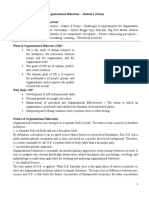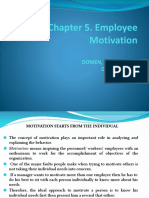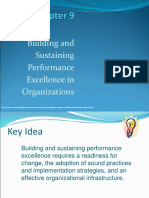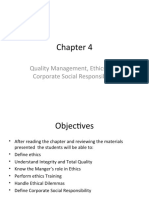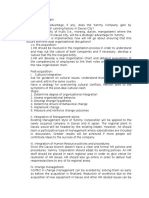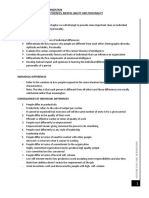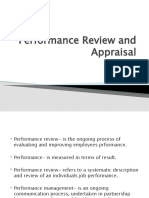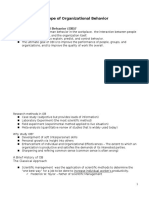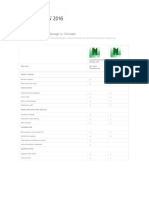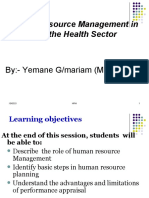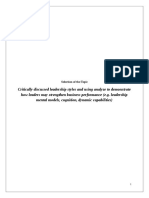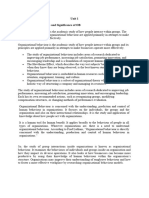0 ratings0% found this document useful (0 votes)
420 viewsManaging Employee Attitudes and Well-Being
Managing Employee Attitudes and Well-Being
Uploaded by
JayChristian QuimsonThe document outlines several models for understanding job satisfaction, emotions, attitudes, and their relationship to employee behavior and well-being. It discusses the exit-voice-loyalty-neglect model of responses to job dissatisfaction and defines attitudes as clusters of beliefs, feelings, and intentions. It also discusses organizational commitment, stress and its sources/management, the impact of personality on emotions/attitudes/well-being, and models linking these factors to job performance and satisfaction.
Copyright:
© All Rights Reserved
Available Formats
Download as DOCX, PDF, TXT or read online from Scribd
Managing Employee Attitudes and Well-Being
Managing Employee Attitudes and Well-Being
Uploaded by
JayChristian Quimson0 ratings0% found this document useful (0 votes)
420 views2 pagesThe document outlines several models for understanding job satisfaction, emotions, attitudes, and their relationship to employee behavior and well-being. It discusses the exit-voice-loyalty-neglect model of responses to job dissatisfaction and defines attitudes as clusters of beliefs, feelings, and intentions. It also discusses organizational commitment, stress and its sources/management, the impact of personality on emotions/attitudes/well-being, and models linking these factors to job performance and satisfaction.
Original Description:
Explains the factors that may affect the employees work ability.
Original Title
Managing Employee Attitudes and Well-being
Copyright
© © All Rights Reserved
Available Formats
DOCX, PDF, TXT or read online from Scribd
Share this document
Did you find this document useful?
Is this content inappropriate?
The document outlines several models for understanding job satisfaction, emotions, attitudes, and their relationship to employee behavior and well-being. It discusses the exit-voice-loyalty-neglect model of responses to job dissatisfaction and defines attitudes as clusters of beliefs, feelings, and intentions. It also discusses organizational commitment, stress and its sources/management, the impact of personality on emotions/attitudes/well-being, and models linking these factors to job performance and satisfaction.
Copyright:
© All Rights Reserved
Available Formats
Download as DOCX, PDF, TXT or read online from Scribd
Download as docx, pdf, or txt
0 ratings0% found this document useful (0 votes)
420 views2 pagesManaging Employee Attitudes and Well-Being
Managing Employee Attitudes and Well-Being
Uploaded by
JayChristian QuimsonThe document outlines several models for understanding job satisfaction, emotions, attitudes, and their relationship to employee behavior and well-being. It discusses the exit-voice-loyalty-neglect model of responses to job dissatisfaction and defines attitudes as clusters of beliefs, feelings, and intentions. It also discusses organizational commitment, stress and its sources/management, the impact of personality on emotions/attitudes/well-being, and models linking these factors to job performance and satisfaction.
Copyright:
© All Rights Reserved
Available Formats
Download as DOCX, PDF, TXT or read online from Scribd
Download as docx, pdf, or txt
You are on page 1of 2
HANDOUT #14
Exit-voice-loyalty-Neglect (EVLN) model A
model that outlines the consequences of job
dissatisfaction
MANAGING EMPLOYEE
ATTITUDES and WELL-BEING
EMOTIONS IN THE WORKPLACE
Job Satisfaction and Work Behavior
Four ways in which employees respond to
dissatisfaction:
So what are emotions?
-
Emotions, Attitudes, and Behavior
Attitudes Clusters of beliefs, assessed
feelings, and behavioral intentions toward a
person, object, or event
Three components of Attitudes:
Emotions are physiological, behavioral
and psychological episodes experiences
toward an object, person, or event that
create a state of readiness.
Beliefs
Feelings
Behavioral intentions
Exit
Voice
Loyalty
Neglect
Job Satisfaction and Performance
The job performance leads to job satisfaction,
but only when performance is linked to value
rewards.
Job Satisfaction and Customer Satisfaction
Employee-Customer-Profit Chain Model
ORGANIZATIONAL COMMITMENT
Model of Emotions, Attitudes, and Behavior
Cognitive Dissonance An uncomfortable
tension experienced
when
behavior is
inconsistent with our attitudes.
JOB SATISFACTION A persons evaluation of his or her job and work context.
An employees emotional attachment to,
identification with, and involvement in a
particular organization.
Watch Out for Continuance Commitment
Continuance commitment an employees
calculative attachment to an organization,
whereby an employee is motivated to stay only
because leaving would be costly
Building Organizational Commitment
Ways to Build Organizational Loyalty
Justice and support
Shared values
Trust
Organizational Comprehension
Employee Involvement
WORK-RELATED STRESS AND ITS
MANAGEMENT
Stress An adaptive response to a situation that
is perceived as challenging or threatening to a
persons well-being.
General Adaption Syndrome A model of the
stress experience, consisting of three stages:
alarm reaction, resistance, and exhaustion.
Consequences of Distress
Stress takes its toll on the human body. Many
people experience tension headaches, muscle
pain, and related problems due to muscle
contractions from the stress response
Stressors: The Sources of Stress
Psychological harassment
Sexual harassment
Work Overload
Low Task Control
Managing Work-Related Stress
Withdraw from the Stressor one set of
strategies for minimizing workplace stress is to
permanently or temporarily remove
Stress Management Strategy
Withdraw from the stressor
Change stress perceptions
Control stress consequences
Receive social support
Remove the Stressor
Work-Life Balance A state of minimal conflict
between work and non-work demands.
PERSONALITY EFFECTS ON
ATTITUDES AND WELL-BEING
Personality The relatively stable pattern of
behaviors and consistent internal states that
explains a persons behavioral tendencies.
The Big Five Personality Dimensions
Conscientiousness
Agreeableness
Neuroticism
Openness to experience
Extroversion
Effects of Personality on Emotions and
Attitudes
To some extent peoples emotions are
influenced by their personalities, not just by their
workplace experiences.
Effects of Personality on Stress and WellBeing
Because personality affects our moods and
emotions, it also influences our stress reactions
to the work environment.
Effects of Personality on Performance
These five personality dimensions affect workrelated behavior and job performance to varying
degrees.
Effects of Personality on Career Satisfaction
Hollands Six Types of Personalities and Work
Environments
Realistic
Investigative
Artistic
Social
Enterprising
Conventional
You might also like
- Critically Assess Whether A Performance Management System Would Work For Such A Small BusinessDocument2 pagesCritically Assess Whether A Performance Management System Would Work For Such A Small Businessbabashet50% (4)
- Managing Human Resources The New Normal (Ingrid L. Potgieter, Nadia Ferreira)Document343 pagesManaging Human Resources The New Normal (Ingrid L. Potgieter, Nadia Ferreira)macarena100% (2)
- Chapter Two Relevant Information and Decision Making: 5.1 The Role of Accounting in Special DecisionsDocument11 pagesChapter Two Relevant Information and Decision Making: 5.1 The Role of Accounting in Special DecisionsshimelisNo ratings yet
- Stress Management and Well-BeingDocument4 pagesStress Management and Well-BeingAngelene FranciscoNo ratings yet
- Cast StudyDocument7 pagesCast StudyEdelyn De la CruzNo ratings yet
- Chapter 05 - Foundation of Employee MotivationDocument8 pagesChapter 05 - Foundation of Employee MotivationCarol YapNo ratings yet
- Chapter 6 - Managing in Global EnvironmentDocument36 pagesChapter 6 - Managing in Global EnvironmentHaryadi WidodoNo ratings yet
- OB ModuleDocument22 pagesOB Modulerahul ramesh100% (1)
- Job DesigningDocument37 pagesJob DesigningPranav D. Potekar100% (2)
- Ramp DesignDocument9 pagesRamp DesignJayChristian QuimsonNo ratings yet
- Engstrom Auto Mirro Plant Case Studies FFDocument2 pagesEngstrom Auto Mirro Plant Case Studies FFNikku SinghNo ratings yet
- Leverage and Capital StructureDocument63 pagesLeverage and Capital Structurepraveen181274100% (1)
- Managing in A Global EnvironmentDocument44 pagesManaging in A Global Environmentairies barbosaNo ratings yet
- Om Functional Areas PDFDocument26 pagesOm Functional Areas PDFAnonymous Qp7UBGgNo ratings yet
- Chapter 1 - Introduction To OBDocument25 pagesChapter 1 - Introduction To OBLex100% (2)
- Reality Check: Ideal Versus Actual Performance Management SystemDocument9 pagesReality Check: Ideal Versus Actual Performance Management Systemextra fileNo ratings yet
- Chapter 5 HRMDocument47 pagesChapter 5 HRMJennalynNo ratings yet
- Introduction To Organizational Behavior: Mcgraw-Hill/IrwinDocument49 pagesIntroduction To Organizational Behavior: Mcgraw-Hill/IrwinKareem RasmyNo ratings yet
- Unit 1 Concept of Human Resources ManagementDocument2 pagesUnit 1 Concept of Human Resources ManagementPrajita ShresthaNo ratings yet
- Chapter 5 Employee MotivationDocument22 pagesChapter 5 Employee MotivationChristian MagbanuaNo ratings yet
- Hbo - Motivation 1Document52 pagesHbo - Motivation 1Julieta Granada AsuncionNo ratings yet
- Accounts Receivable ManagementDocument14 pagesAccounts Receivable ManagementJay-ar Castillo Watin Jr.No ratings yet
- Organizational Behavior: Understanding Work TeamsDocument19 pagesOrganizational Behavior: Understanding Work TeamsdewpraNo ratings yet
- HRM Reflections 4Document5 pagesHRM Reflections 4Julieta Granada AsuncionNo ratings yet
- 603 P&CM Unit 1 Performance ManagementDocument15 pages603 P&CM Unit 1 Performance ManagementFaiyaz panchbhayaNo ratings yet
- Building and Sustaining Performance Excellence in OrganizationsDocument31 pagesBuilding and Sustaining Performance Excellence in OrganizationsYogeswary Selvadura100% (1)
- Changes in Personnel Status (Group 2)Document43 pagesChanges in Personnel Status (Group 2)Rica MalaaNo ratings yet
- Employee Performance AppraisalsDocument8 pagesEmployee Performance AppraisalsPooja ChaudharyNo ratings yet
- Module 2 Stakeholders RelationshipDocument7 pagesModule 2 Stakeholders RelationshipkenNo ratings yet
- IIP Assignment On Maslow's TheoryDocument5 pagesIIP Assignment On Maslow's TheoryPrakriti DuttaNo ratings yet
- Case Study Hughes Distributing CompanyDocument1 pageCase Study Hughes Distributing CompanyJoanna Marie IINo ratings yet
- Case StudyDocument19 pagesCase StudyxyzNo ratings yet
- "Strategic Value Analysis" For Competitive Advantage: Greg YoungDocument13 pages"Strategic Value Analysis" For Competitive Advantage: Greg YoungHeldi SahputraNo ratings yet
- Case Application 2Document8 pagesCase Application 2ehsanul150% (2)
- Chapter 6 CVP AnalysisDocument27 pagesChapter 6 CVP AnalysisMariel Angeli Chan100% (1)
- Nature of People: PA 251: Human Behavior in The OrganizationDocument48 pagesNature of People: PA 251: Human Behavior in The OrganizationBaisheigrid Pia AkmadNo ratings yet
- Business Ethics and Social ResponsibilitiesDocument32 pagesBusiness Ethics and Social ResponsibilitiesRahul KumarNo ratings yet
- Significance of Human Behavior Patterns in Management ControlDocument11 pagesSignificance of Human Behavior Patterns in Management ControlVishal SuryvanshiNo ratings yet
- Quality Management, Ethics, and Corporate Social ResponsibilityDocument14 pagesQuality Management, Ethics, and Corporate Social ResponsibilityAllain GuanlaoNo ratings yet
- 01 The Nature of Strategic ManagementDocument47 pages01 The Nature of Strategic ManagementFahim AhmedNo ratings yet
- Chapter 3 - Attitudes and Job SatisfactionDocument18 pagesChapter 3 - Attitudes and Job SatisfactionKuba OstaNo ratings yet
- Transcript of CASEDocument7 pagesTranscript of CASEIrishCrystalBeltran100% (1)
- Answers Acct 504 Case Study 2Document3 pagesAnswers Acct 504 Case Study 2Mohammad IslamNo ratings yet
- Chapter 4 - Managing in A Global EnvironmentDocument5 pagesChapter 4 - Managing in A Global Environmentbiancag_91No ratings yet
- Human Behavior in Organization Chapter 2-Individual Differences, Mental Ability and PersonalityDocument3 pagesHuman Behavior in Organization Chapter 2-Individual Differences, Mental Ability and PersonalityRocelle M. Joyce HermosuraNo ratings yet
- Developing and Assisting MembersDocument12 pagesDeveloping and Assisting MembersJouana Farlin SevaNo ratings yet
- Chapter 1Document37 pagesChapter 1phirlayayadilNo ratings yet
- Theories of Motivation: by DR Anjali BansalDocument43 pagesTheories of Motivation: by DR Anjali BansalvickyambureNo ratings yet
- Quality Awards and QualityDocument22 pagesQuality Awards and Qualitykhalid7861No ratings yet
- David sm13 PPT 09Document24 pagesDavid sm13 PPT 09Alejandro Perez SantanaNo ratings yet
- MGMT1011 Lecture Block 3a - MotivationDocument28 pagesMGMT1011 Lecture Block 3a - MotivationNew MoviesNo ratings yet
- HRM5 Training of EmployeesDocument13 pagesHRM5 Training of EmployeesarantonizhaNo ratings yet
- Week 2 - Human Resource Management Strategy and AnalysisDocument35 pagesWeek 2 - Human Resource Management Strategy and AnalysisUsman LodhiNo ratings yet
- CHAPTER 6 Performance Review and AppraisalDocument5 pagesCHAPTER 6 Performance Review and AppraisalPatricia Louise Sy GuardianaNo ratings yet
- Chapt 5 - HRMDocument19 pagesChapt 5 - HRMRaniel R BillonesNo ratings yet
- Chapter 1 - Nature and Scope of OBDocument3 pagesChapter 1 - Nature and Scope of OBvacinad100% (1)
- Management RolesDocument4 pagesManagement RolesSaroj KumarNo ratings yet
- Quality Teamwork: Quality & Performance Excellence, 8 EditionDocument20 pagesQuality Teamwork: Quality & Performance Excellence, 8 EditionAisah Reem100% (1)
- Operation ManagementDocument34 pagesOperation ManagementAyushNo ratings yet
- Emotions & AttitudeDocument37 pagesEmotions & AttitudeShraddha ShrivastavaNo ratings yet
- Chapter 14 Managing Employee AttitudeDocument22 pagesChapter 14 Managing Employee AttitudeJon MerazNo ratings yet
- Attitudes and Job SatisfactionDocument19 pagesAttitudes and Job SatisfactionAshish GuptaNo ratings yet
- Positive AttitudesDocument10 pagesPositive AttitudesRajeshsharmapurangNo ratings yet
- 1.1 Cover CONCRETE SPECIFICATIONDocument1 page1.1 Cover CONCRETE SPECIFICATIONJayChristian QuimsonNo ratings yet
- Diaphragm Design Manual: C AijDocument1 pageDiaphragm Design Manual: C AijJayChristian QuimsonNo ratings yet
- Dragonpay Payment InstructionDocument1 pageDragonpay Payment InstructionJayChristian QuimsonNo ratings yet
- Utilization Ratio (Demand Over Capacity)Document3 pagesUtilization Ratio (Demand Over Capacity)JayChristian QuimsonNo ratings yet
- Navisworks Compare PDFDocument1 pageNavisworks Compare PDFaneethavilsNo ratings yet
- Building A RampDocument10 pagesBuilding A RampJayChristian QuimsonNo ratings yet
- Arbortext Editor Data SheetDocument3 pagesArbortext Editor Data SheetJayChristian QuimsonNo ratings yet
- Intel Graphics Driver 24.20.100.6136Document3 pagesIntel Graphics Driver 24.20.100.6136JayChristian QuimsonNo ratings yet
- Seismic Loads For Design of Structures (UBC-1997) - EngineersBayDocument10 pagesSeismic Loads For Design of Structures (UBC-1997) - EngineersBayJayChristian QuimsonNo ratings yet
- Passware Kit Forensic DatasheetDocument2 pagesPassware Kit Forensic DatasheetJayChristian QuimsonNo ratings yet
- Consteel Version InformationDocument38 pagesConsteel Version InformationJayChristian QuimsonNo ratings yet
- Bridge Repair CostDocument10 pagesBridge Repair CostJayChristian QuimsonNo ratings yet
- Components of Performance Management in NursingDocument14 pagesComponents of Performance Management in Nursingrubiecabs12No ratings yet
- Case Study Employee Bahaviour in Regency HotelDocument3 pagesCase Study Employee Bahaviour in Regency HotelGerin BuenoNo ratings yet
- Theory X and Theory YDocument7 pagesTheory X and Theory YdanballaisNo ratings yet
- Components or Elements of Human Resources ManagementDocument1 pageComponents or Elements of Human Resources ManagementRub BingNo ratings yet
- O B McqsDocument3 pagesO B McqsYousaf JamalNo ratings yet
- Materi 7: Motivating and Managing People and Groups in Business OrganizationsDocument28 pagesMateri 7: Motivating and Managing People and Groups in Business OrganizationsChikita DindaNo ratings yet
- Job Analysis of HR OfficerDocument14 pagesJob Analysis of HR OfficerSadia JamalNo ratings yet
- Research For PusposesDocument7 pagesResearch For PusposesGerald Sucalit GabasNo ratings yet
- US Recruiter JDDocument1 pageUS Recruiter JDcocmanish250396No ratings yet
- Publishing As Prentice Hall: Management, Eleventh Edition by Stephen P. Robbins & Mary CoulterDocument32 pagesPublishing As Prentice Hall: Management, Eleventh Edition by Stephen P. Robbins & Mary CoulterallanrnmanalotoNo ratings yet
- Unilever HR Metrics People PerformanceDocument1 pageUnilever HR Metrics People PerformanceLinh Phan ThùyNo ratings yet
- HRElective Project TusharWadhwaDocument5 pagesHRElective Project TusharWadhwaSahil Wadhwa0% (1)
- Human Resource Management in The Health Sector: By:-Yemane G/mariam (MPH in HSM)Document31 pagesHuman Resource Management in The Health Sector: By:-Yemane G/mariam (MPH in HSM)ruthNo ratings yet
- Chapter - I: Rationale Behind The StudyDocument82 pagesChapter - I: Rationale Behind The StudysudhakarhandsomeNo ratings yet
- Talent ManagementDocument8 pagesTalent Managementyared haftuNo ratings yet
- Assignment 3 Leadership FinalDocument19 pagesAssignment 3 Leadership FinalMaryam AsadNo ratings yet
- BSBTWK502 - Presentation Week 1 2024Document39 pagesBSBTWK502 - Presentation Week 1 2024Emerson RodriguezNo ratings yet
- Creating a Culture of Continuous Learning and DevelopmenDocument15 pagesCreating a Culture of Continuous Learning and DevelopmennandigamaNo ratings yet
- 3-I Internal Question Bank CMDocument5 pages3-I Internal Question Bank CMdpreethi199No ratings yet
- Optional 2Document13 pagesOptional 2m2022phhp017No ratings yet
- Unit 1Document20 pagesUnit 1Prakrity JaiswalNo ratings yet
- IO Final Quizes 1Document38 pagesIO Final Quizes 1Aji Nikka Angeles100% (2)
- Talent AcquisitionDocument10 pagesTalent AcquisitionMuhammad AliNo ratings yet
- HR Status Analysis of Opsonin PharmaDocument9 pagesHR Status Analysis of Opsonin Pharmarisbd appliancesNo ratings yet
- MG 201 Assignment 1 s11145116Document4 pagesMG 201 Assignment 1 s11145116sonam sonikaNo ratings yet
- 2YDjHouxva HR Specialist OfficerDocument12 pages2YDjHouxva HR Specialist OfficerSudarsshan KetheyNo ratings yet
- Coaching, Career and Talent ManagementDocument13 pagesCoaching, Career and Talent ManagementCindy KusumaNo ratings yet
- Get What S Wrong With Leadership Improving Leadership Research and Practice Ronald E Riggio PDF Ebook With Full Chapters NowDocument39 pagesGet What S Wrong With Leadership Improving Leadership Research and Practice Ronald E Riggio PDF Ebook With Full Chapters Nowzelinomadeo100% (6)







